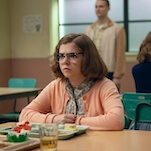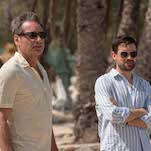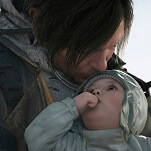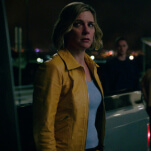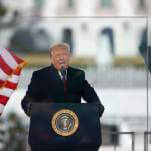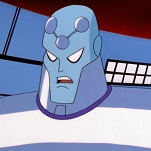Horizon Zero Dawn Scribbles a To-Do List Over a Post Card
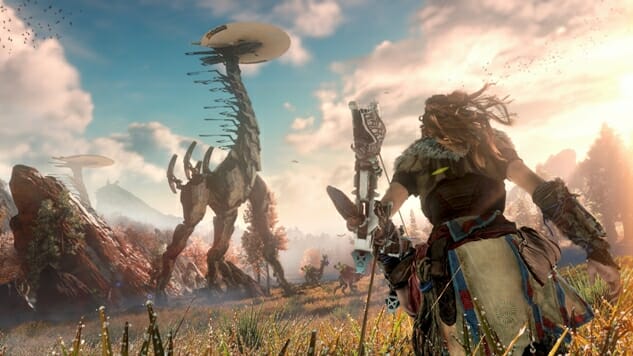
Guerilla Games’ Horizon Zero Dawn looks like a living nature painting. As the player runs or rides from one settlement to another, the landscape constantly shifts between distinct, gorgeously realized biomes. One minute, it’s a frozen tundra, with sun gleaming off enormous white, snow-covered cliffs, and ground covered in scraggly little bushes and errant branches. The next, it’s an orange sanded desert with towering red clay mesas jutting up into a perfectly clear blue sky. In each, birds and foxes, boar and rabbits frolic. (And, because Zero Dawn is science fiction, herds of robotic bulls, flocks of giant metal birds or a lone, lumbering cybernetic tyrannosaur.) The world is genuinely stunning, a place that wants simply to be soaked in—observed and inhabited. It is our planet in miniature. It’s the globe shrunk down and captured in a videogame console. Sweep the in-game camera around a landscape and it’s almost possible to smell the air or feel the warmth of the sun.
But, Zero Dawn is an action game, after all, and the screen is covered in reminders of this: A health bar at the top left; an icon displaying potions and another showing weapons and ammunition on the bottom; a line of text summing up the current mission the player is trying to complete. Zoom the map out to find where to go and the priorities of the game become even clearer. Icons—a sea of mission markers, collectable locations and travel-skipping campfire spots—cover the world map like vicious acne. This incredibly realized setting, not allowed to exist for its own sake, is ultimately subsumed by a nearly endless array of activities and busywork, its beauty sacrificed to the god of Content.
Aloy, Zero Dawn’s protagonist, belongs to the Nora tribe, hunter-gatherers who live in a far-flung future where humanity has forgotten centuries of accumulated knowledge and forged new cultures and civilizations. Unlike our own ancient past, the game’s humans live in an ecosystem where autonomous robot animals wander outside cities that range in sophistication from ramshackle collections of huts to a sprawling town surrounding an ornate, Gothic-spired palace.
The setting’s mix of familiar and strange sights draws curiosity. Aloy is motivated to learn about why she had to be raised outside of the Nora tribe—why others say there’s something inherently wrong with her and is shunned as a result. On her journey to uncover her own history, she’s drawn across the entirety of the in-game map, taking in astonishing vistas littered with puzzling industrial wreckage, high tech machines and an array of robot creatures. Zero Dawn isn’t content to allow this welcome sense of mystery to linger. The resulting story mixes a young adult novel’s shallow characterization—Aloy’s personality is nothing but bland heroism, occasional sarcasm and knowledge that she is the world’s “chosen one”—with the dull, self-obsessed historical cataloguing of bad science fiction novels eager to justify their conceits in exhaustive length.
None of the characters feel like much more than chess pieces. They exist only to fulfill roles needed for the plot to develop, spouting information on political and cultural institutions, the back stories of cast members Aloy hasn’t met and other miscellanea better suited to an appendix than labored dialogue sequences. All of this is in service to the most tiring of genre exercises—detailing every possible variable of a fantasy world, giving the audience answers to any possible question about what this world is and how it came to be. If this plot paid off in any interesting ways, it would go some way toward excusing Zero Dawn’s faults. As it is, players are given a predictable science fiction story that attempts, at great length, to condemn environmental exploitation while success in the game itself is predicated on viewing the natural world as nothing more than a wide assortment of collectable resources (more on this in a bit).
The worst tendencies of this storytelling style become particularly clear in a handful of segments where the game forces Aloy to walk—and scan objects with her temple-mounted computer system—through defunct laboratories and research facilities. These spaces are filled with collectable text and audio files and hologram displays that provide exposition and establish new stakes for the plot. The sequences are exhausting, pace-breaking interludes that show a distinct failure to integrate key plot advancements with the rest of the game’s action. The most interesting relate specifically to Aloy’s background. But even as they provide enormous personal revelations for her to react to, the character is too flat to do much more than be taken aback for a few moments and revert back to her usual mode: nondescript adventurer.
Zero Dawn is marginally more successful when keeping Aloy in this role. The mix of combat, climbing and crafting that makes up the rest of the game is superficially enjoyable. The mainstay bows and arrows—varieties include long-range for sniping, armor-chipping for knocking bits off robots and that old standby “on fire”—carry a satisfying rhythm of knocking, drawback and firing. Laying down proximity bombs and exploding trap lines along the holographically marked path of wandering dinobots is a good reward for patience, and simply bashing an enemy with Aloy’s spear offers the welcome feedback of flying sparks and collapsing metal.




